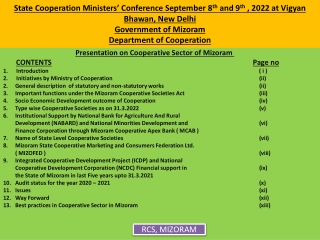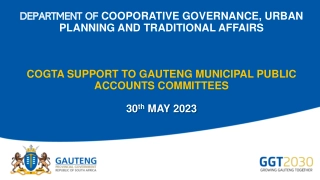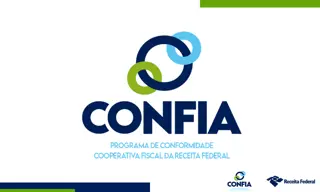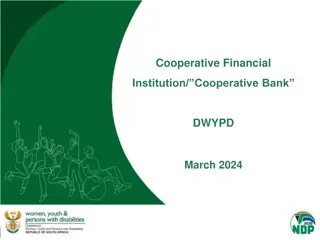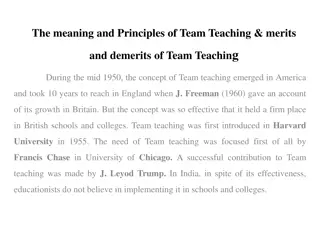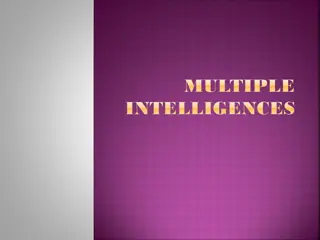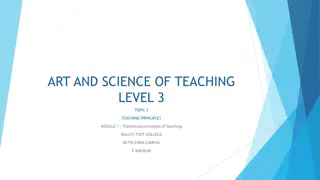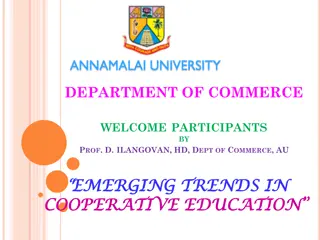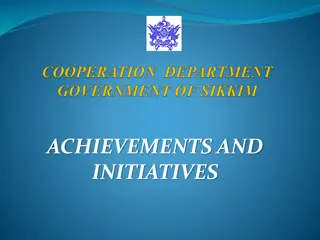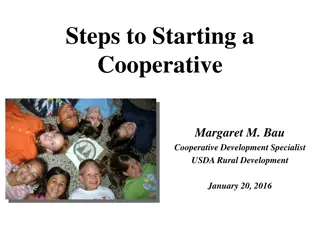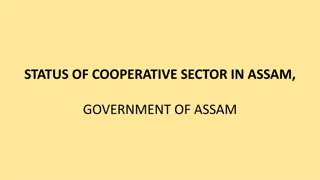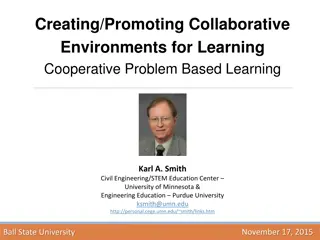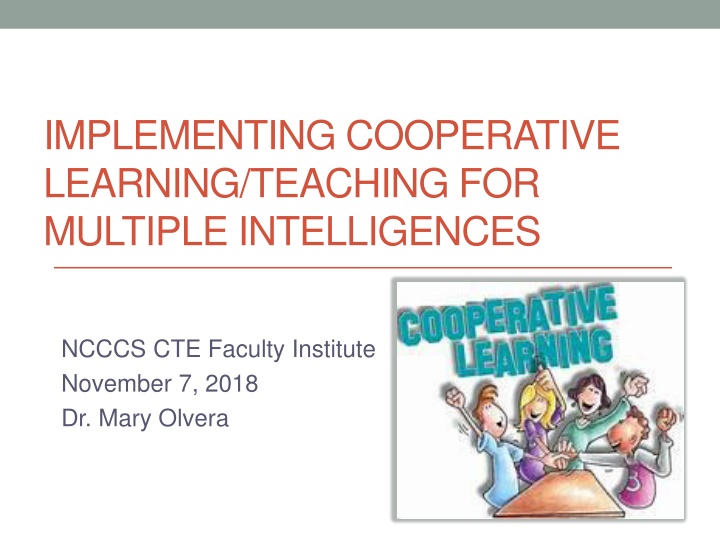
Cooperative Learning Strategies for Multiple Intelligences in Education
Explore how implementing cooperative learning strategies cater to multiple intelligences, allowing students to engage, learn, and succeed based on their unique strengths and preferences. Understand the importance of accommodating diverse learning styles to enhance student involvement and academic success in higher education.
Download Presentation

Please find below an Image/Link to download the presentation.
The content on the website is provided AS IS for your information and personal use only. It may not be sold, licensed, or shared on other websites without obtaining consent from the author. If you encounter any issues during the download, it is possible that the publisher has removed the file from their server.
You are allowed to download the files provided on this website for personal or commercial use, subject to the condition that they are used lawfully. All files are the property of their respective owners.
The content on the website is provided AS IS for your information and personal use only. It may not be sold, licensed, or shared on other websites without obtaining consent from the author.
E N D
Presentation Transcript
IMPLEMENTING COOPERATIVE LEARNING/TEACHING FOR MULTIPLE INTELLIGENCES NCCCS CTE Faculty Institute November 7, 2018 Dr. Mary Olvera
Activity #1 Think about your most memorable learning experience.
Intelligence Intelligence is the ability to find and solve problems and create products of value in one s own culture -Dr. Howard Gardner Intelligence is pluralistic. There are many ways to be intelligent. Multiple intelligence strategies value and invite multiple ways to explore a topic, deepen understanding of it, and build related skills.
Types of Intelligence: Forms of Analysis Linguistic (poet); Logical-mathematical (scientist); Musical (composer); Spatial intelligence (sculptor or airplane pilot); Bodily kinesthetic (athlete or dancer); Interpersonal (salesman or teacher); Intrapersonal (self-aware). Naturalistic (botanist or zoologist). Existential (philosopher).
What Does the Research Say? Weber (2011) stated that even though studies indicate that many college freshmen reported disinterest and boredom, institutions of higher learning tend to neglect active student involvement (p. 1). Bias toward a particular learning style for instructional delivery may disadvantage some groups of learners and that if the individual preferences of students are ignored, those already most at risk of withdrawal or failure are put in double jeopardy (Smith, 2012, p. 64,66).
What Does the Research Say? Lecture appears to be the most prominent form of instructional delivery in higher education, although, only about 25% of higher education students prefer the verbal learning style. Lecture style teaching may be efficient but not necessarily effective (Turner, 2009).
What Does the Research Say? There are substantial differences in the learning preferences of students with high academic success and students with low academic success (Honigsfield and Dunn, 2006) . Learning styles dictate how individuals respond to the learning environment (Evans, Cools, and Charlesworth, 2010) .
What Does the Research Say? When learning styles are accommodated, the result is increased: Productivity Academic achievement Creativity Students learn better, smarter, faster, and return more information when operating in preferred learning style. Interesting Fact: Learning styles change with age. Linguistic Intelligence increases with age Bodily-Kinesthetic, Interpersonal decrease with age.
Activity #2 How do your students learn? Think of a class that you are teaching now. Draw a picture to represent your perception of how these students prefer to learn.
Thinking Styles Conceptual Thinkers Big picture, how things work Creative Thinkers Seek answers to problems, trouble shooters Practical Thinkers Interested only in the facts Reflective Thinkers Effective at connecting new information with prior knowledge
Collaborative Learning Cooperative learning is one of the most widespread and fruitful areas of theory, research, and practice in education. To engage adult learners: Relationship Relevancy Responsibility Discussion: Pros and Cons of Group Projects
Collaborative Learning Strategies Big Group Projects Grading: Group, Individual, Peer Research Model: Names in order of greatest contribution Structure, Composition of the Group Roles Group Contract Smaller or Low-Stakes Collaborative Tasks Mini-lectures Think, Pair, Share Mock Situations/Role Playing Reciprocal Teaching
Collaborative Learning Strategies Group Tests Group Writing Assignments Assessment Choice All collaborative assignments should be: Intentionally planned Identify clear goals and expectations (social & academic) Explain structure or process for organizing structure For big projects, periodic updates
Activity #4 Group Activity Share strategies you currently use to address the diversity of preferred intelligences in your classroom.
Activity #5 Group Activity Share your ideas with the whole group.
Conclusion Everyone has ALL the intelligences. The intelligences are not mutually exclusive - they act in consort. MI Theory was not developed to exclude individuals, but to allow all people to contribute to society through their own strengths. Walter McKenzie
References Dede, C. (2005). Planning for neomillenial learning styles. Educause Quarterly. Evans, C., Cools, E., & Charlesworth, Z. M. (2010). Learning in higher education - how cognitive and learning styles matter. Teaching In Higher Education, 15(4), 467-478. doi:10.1080/13562517.2010.493353 Gardner, H. (n.d). Intelligence in seven steps. John Hopkins University. Retrieved from http://education.jhu.edu Hauer, J., & Quill, T. (2011). Educational needs assessment, development of learning objectives, and choosing a teaching approach. Journal of Palliative Medicine, 14(4), 503-508. doi:10.1089/jpm.2010.0232 Honigsfeld, A., & Dunn, R. (2006). Learning-style characteristics of adult learners. Delta Kappa Gamma Bulletin, 72(2), 14-31 Landrum, T. J., & McDuffie, K. A. (2010). Learning styles in the age of differentiated instruction. Exceptionality, 18(1), 6-17. doi:10.1080/09362830903462441. Multiple Intelligence Institute. (2008). Moving from theory to Practice. MI Institute. Retrieved http://www.miiinstitute.info/uploads/download/Moving_from_Theory_to_P ractice.pdf.
References Postholm, M. (2008). Group work as a learning situation: a qualitative study in a university classroom. Teachers & Teaching, 14(2), 143-155. doi:10.1080/13540600801965978 Russell, S. S. (2006). An overview of adult-learning processes. Urologic Nursing, 26(5), 349-370. Smith, J. (2002). Learning styles: Fashion fad or lever for change? The application of learning style theory to inclusive curriculum delivery. Innovations In Education & Teaching International, 39(1), 63-70. doi:10.1080/13558000110102913. Turner, P. M. (2009). Next generation: Course redesign. Change, 41(6), 10-16. Viens, J. (2011). Putting MI theory to work: Keystones of MI theory and MI practice. MI Institute. Retrieved from http://www.miinstitute.info/show/new_view_48.html. Weber, E. (1992). Curriculum for success. New Horizons for Learning: On the Beam. 12(3), 339-340.
References Smith, J. (2002). Learning styles: Fashion fad or lever for change? The application of learning style theory to inclusive curriculum delivery. Innovations in Education & Teaching International, 39(1), 63-70. doi:10.1080/13558000110102913. Smith, M. K. (2002). Malcolm Knowles, informal adult education, self-direction and anadragogy. The encyclopedia of informal education. Retrieved August 24, 2007, from http://www.infed.org/thinkers/et-knowl.htm Weber, E. (1992). Curriculum for success. New Horizons for Learning: On the Beam. 12(3), 339-340. Worley, K. (2011). Educating college students of the net generation. Adult Learning, 22(3), 31-39.




